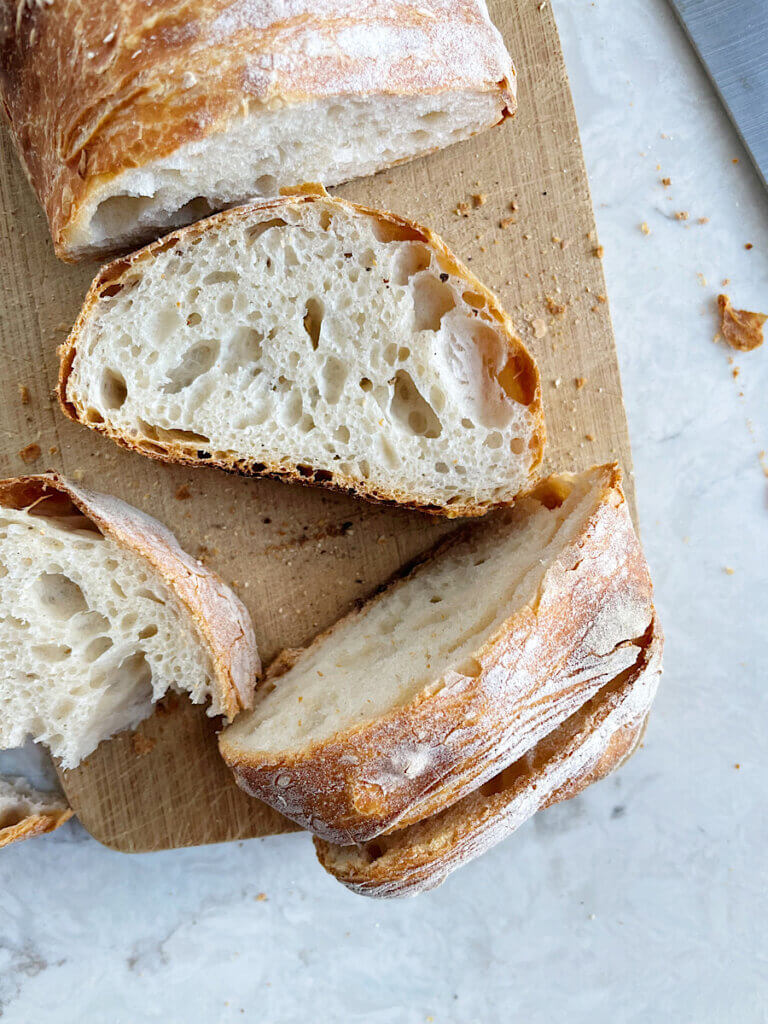
Homemade Ciabatta Bread in your Dutch Oven. Delicious homemade ciabatta bread is easier than you might think! All you need for your ciabatta bread is a few basic ingredients, and a little time. I added a lot of pictures to my Dutch Oven Ciabatta Bread Recipe to make it more easy to follow, because ciabatta bread is not a recipe I would usually recommend for a beginner bread maker.
January 2022 update, I have created a version of this ciabatta bread for the dutch oven! I'm happy to say that the texture is so perfect in this version. I included a video with directions on how to make dutch oven ciabatta. And, separate directions for non dutch oven ciabatta moved to the notes section of the recipe card.
So I just got a standing mixer (an AMAZING gift from my husband) and I am BEYOND excited! I feel like a real chef now! I have always dreamed of having a standing mixer in my kitchen and I finally do! So, I have been making soo many bread recipes. I literally made 3 different kinds of dough in the first day I had it. 🙂 Can you see I'm excited! One of those was a homemade ciabatta bread recipe that I found online from the brown eyed baker. And to my delight, it came out ABSOLUTELY PERFECT the first time! So I have to give her a lot of credit for an amazing recipe and clear directions.
A few things I changed though: I used bread flour instead of all-purpose flour and I used plain yogurt instead of milk.
HOMEMADE CIABATTA BREAD INGREDIENTS
Believe it or not, homemade ciabatta bread takes simple ingredients that you probably already have. I love making bread at home and skipping the mile long ingredient list on the back of store bought breads.
My homemade ciabatta bread recipe has 2 separate days, the first day you mix a pre-ferment also known as a ciabatta bread sponge:
- 1 cup All purpose flour (just for the sponge pre-ferment)
- ⅛ teaspoon Instant yeast
- ½ cup Water
The next day, you add all the rest of the ciabatta bread dough ingredients to your sponge:
- 2 cups Bread flour
- 1 ½ teaspoon finely ground sea salt
- ½ teaspoon instant yeast
- ¾ cup water
- ¼ cup Plain yogurt
My homemade Dutch oven ciabatta bread recipe takes 2 stretch and folds to make the dough stronger. You can use olive oil for your stretch and folds, or, some people simply wet their hands with warm water.
- 2 tablespoons Olive oil (for stretching and folding the dough later)
EQUIPMENT NEEDED TO MAKE HOMEMADE CIABATTA BREAD IN A DUTCH OVEN
- Standing mixer
- Tub for rising the dough
- Parchment paper
- Dutch oven
While you can absolutely make ciabatta bread by hand, a standing mixer saves you a ton of time and muscle power! 🙂
TIPS FOR MAKING THE BEST EVER CIABATTA BREAD RECIPE
MAKE THE SPONGE RIGHT IN THE BOWL OF YOUR STANDING MIXER. Once your sponge has doubled in size, you can add the rest of your ingredients right to it.
COVER YOUR SPONGE TIGHTLY WITH PLASTIC WRAP OR OTHER AIRTIGHT COVER. This helps to create a warm environment for your sponge to rise.
RISE YOUR DOUGH WRAPPED IN A TOWEL IN YOUR OVEN. Keep your oven turned off, but if you have a drafty house, this extra insulation will help a lot with rising ciabatta bread properly.
DON'T SKIP STRETCH AND FOLD. Stretching and folding bread dough redistributes the yeast and helps to strengthen the dough.
SPRAY YOUR DOUGH WITH WATER IF YOU'RE NOT USING A DUTCH OVEN. This is important to create a crispy ciabatta bread without a dutch oven. The spray bottle of water introduces moisture, which creates that signature bread shell.
Try these recipes next!
- Whole Wheat Ciabatta Bread
- Ciabatta Rolls
- Focaccia Bread
- Naan Bread
- Whole Wheat Naan Bread
- Sourdough Cinnamon Rolls
- Sourdough Rainbow Bagels
- Beet Bagels
HOMEMADE CIABATTA BREAD USING A DUTCH OVEN
Watch my new video for a new ciabatta bread technique for a delicious crispy crust and chewy center. I updated couple things in this ciabatta bread recipe, so if you are going to make ciabatta bread in the dutch oven, follow these steps here.
If you want to make ciabatta bread without a dutch oven, follow the steps in the notes section of my recipe card below!
HOW TO MAKE HOMEMADE CIABATTA BREAD WITH A DUTCH OVEN
Homemade ciabatta bread takes a bit of time, but it is well worth it! The first stage is the pre-ferment. You will be mixing flour with water and yeast and letting it sit up to 24 hours, so plan accordingly.
STEP 1: Make the Pre-ferment (Sponge):
A sponge is kind of like a sour dough.. except you only ferment it for ~8-24 hours. It gets those yeast activated for a lot of bubbles and rise in your final product. And since it is not fermented as long as sour dough, you won't have that "sour" dough taste. I love sour dough, but some people don't ! So this is perfect if you want the texture without the sour!
HOW TO MAKE A CIABATTA BREAD SPONGE
Mix the ingredients for your sponge together in a large bowl.
- 1 cup all-purpose flour
- ⅛ tsp instant yeast
- ½ cup water at room temperature
I like to mix them right in the bowl of my standing mixer so I can add the other ingredients the next day.
Mix with a wooden spoon until a ball comes together.
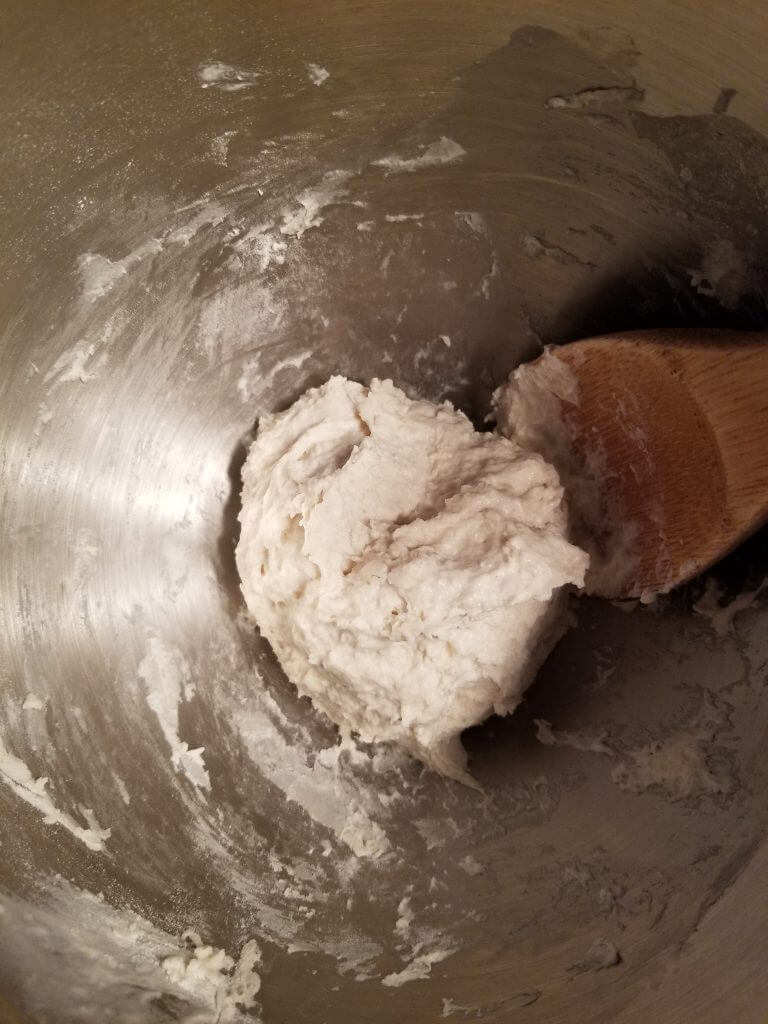
Next, cover your sponge TIGHTLY with either plastic wrap or a beeswax wrap (environmentally friendly plastic wrap alternative). You don't want any air sneaking in while it ferments.
Let it sit out at room temperature for at least 8 hours and up to 24 hours (shorter for warmer kitchens, longer for colder kitchens).
The best way to do it is to make it in the evening before you want to make your ciabatta bread.
This is what mine looked like after ~10 hours:
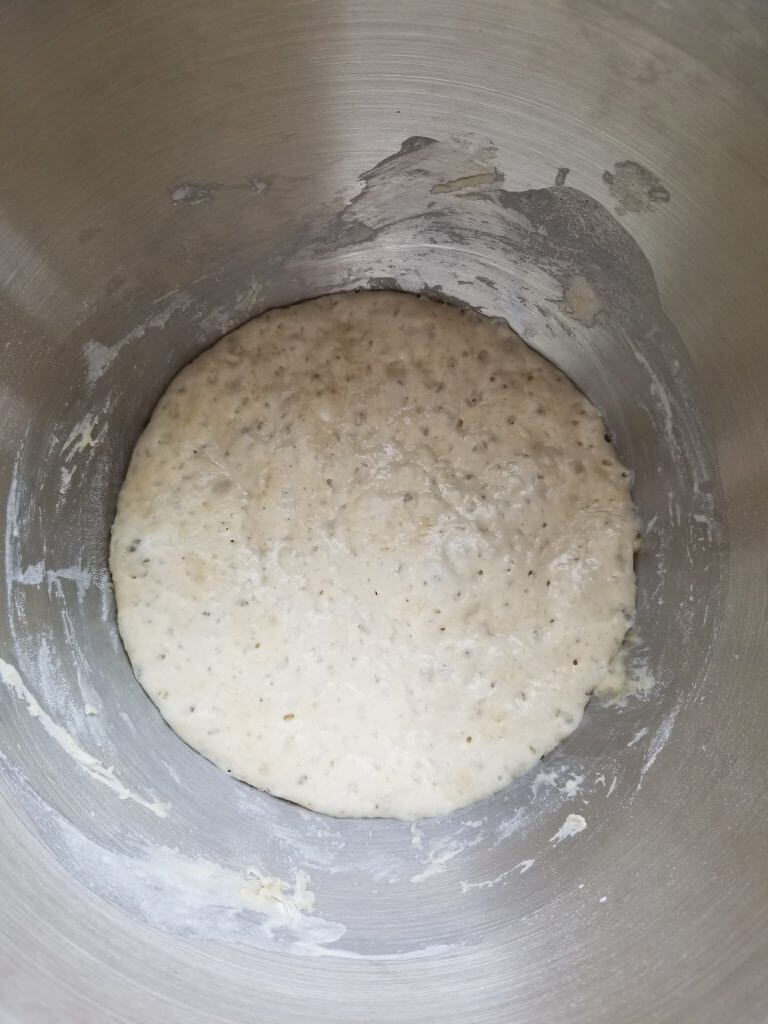
STEP 2: Make the Ciabatta Bread Dough:
Fit your standing mixer with a paddle.
If you are mixing your dough by hand, skip this section and read below.
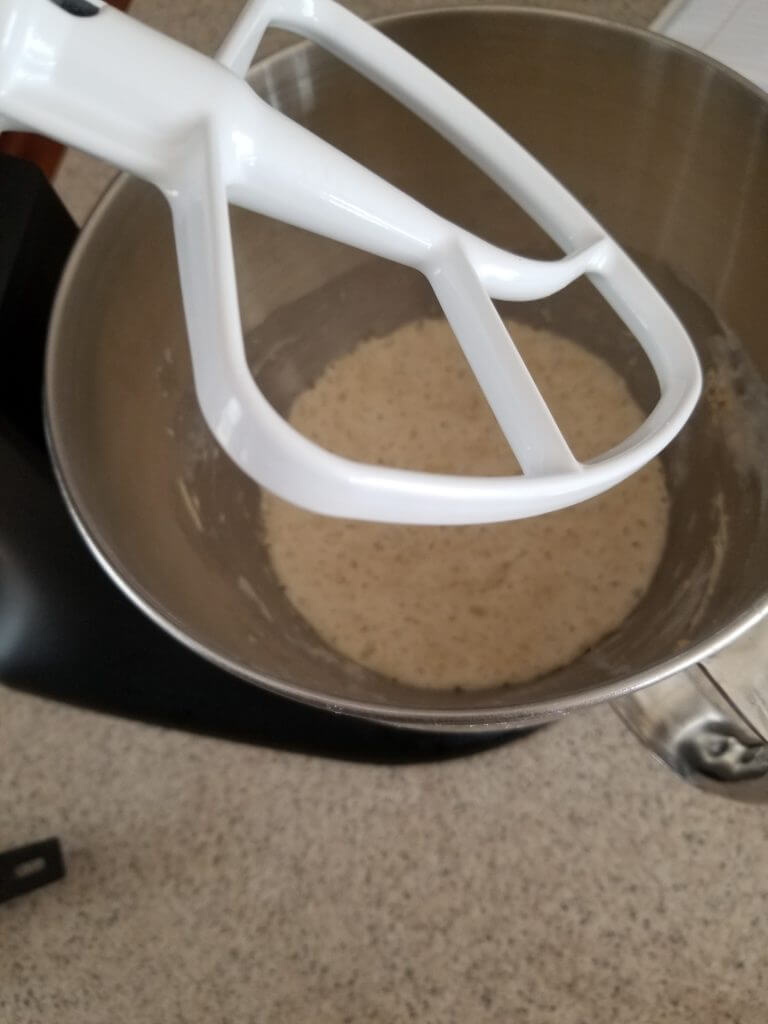
Add all your other ingredients for the homemade ciabatta dough:
- 2 cups bread flour
- 1 ½ tsp salt
- ½ tsp instant yeast
- ¾ cup water at room temperature
- ¼ cup plain yogurt
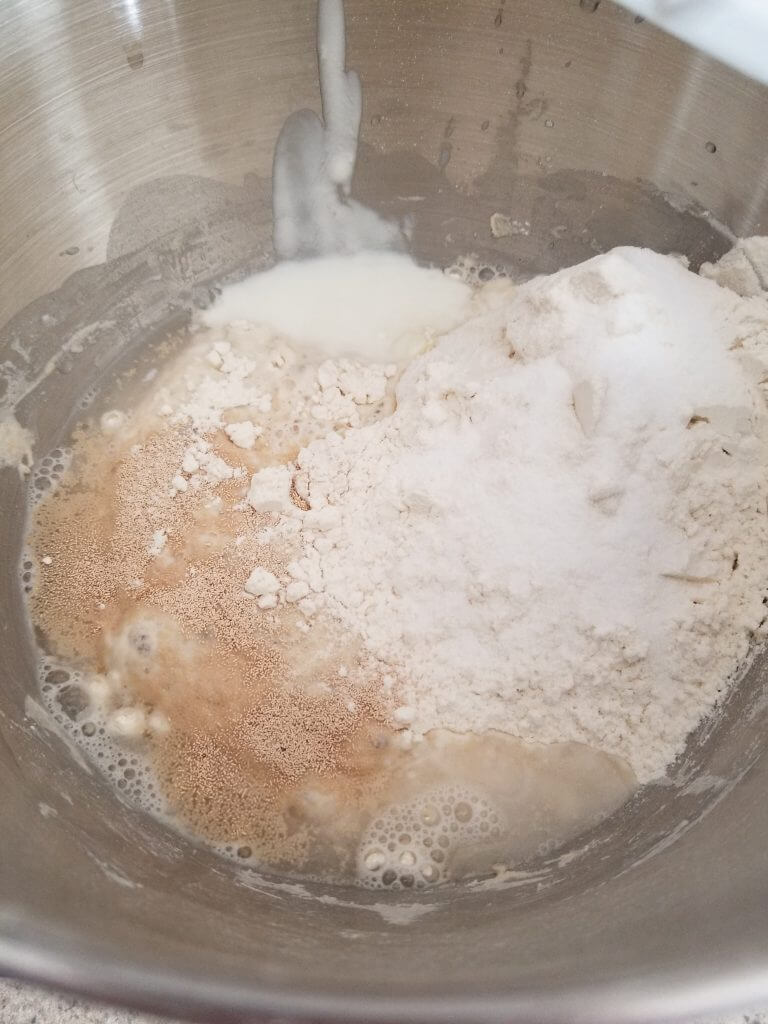
Set your mixer to a LOW speed and mix for ~1 minute. You can turn it off and scrape it as you need.
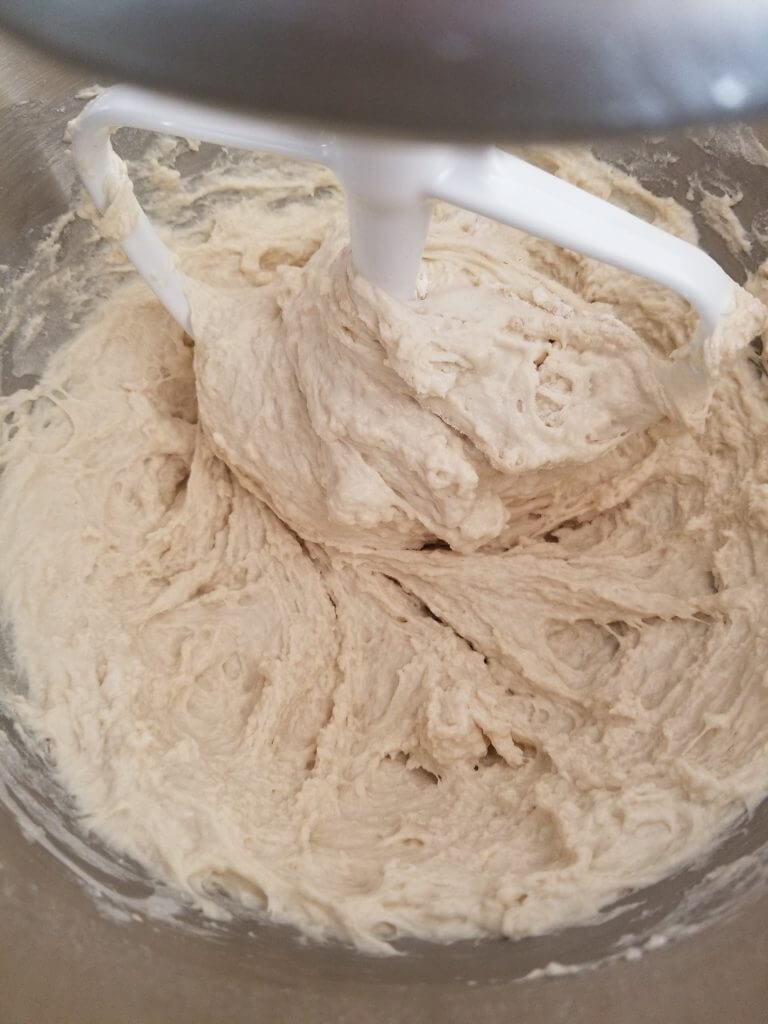
Increase the speed to medium low and mix for ~4-6 minutes, or until the the ciabatta dough pulls away from the sides of the bowl and forms a uniform mass.
It should look like this:
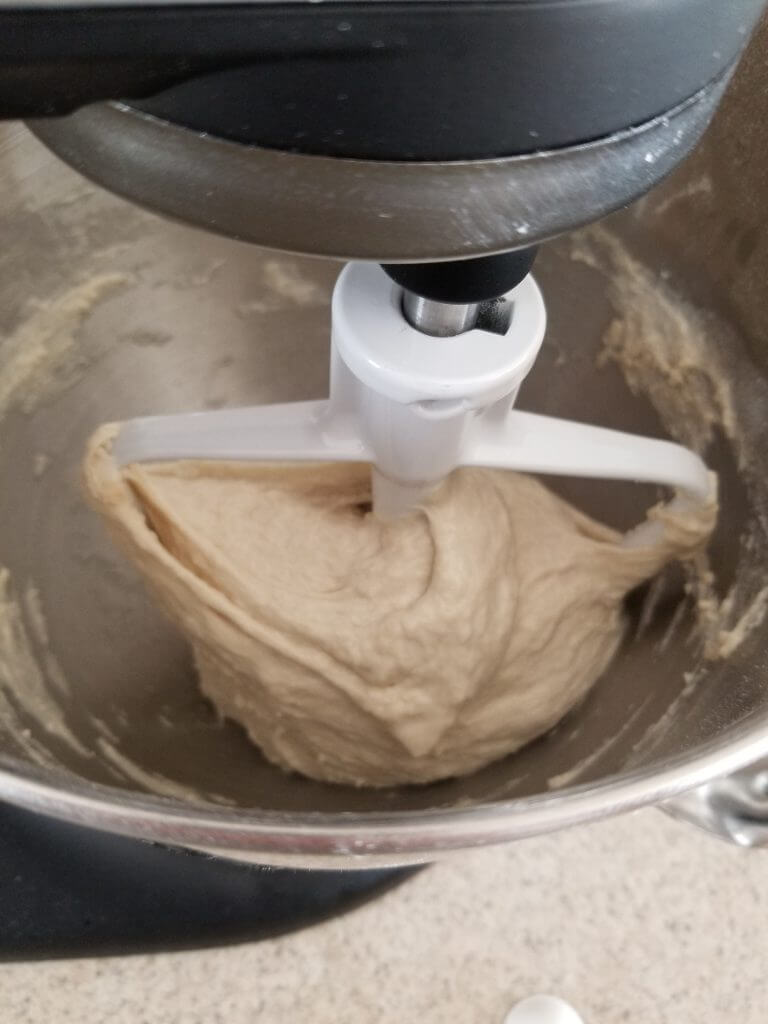
Your homemade ciabatta bread dough will be pretty thin looking! I know it's tempting, but don't add more flour. It will come together the longer you knead!
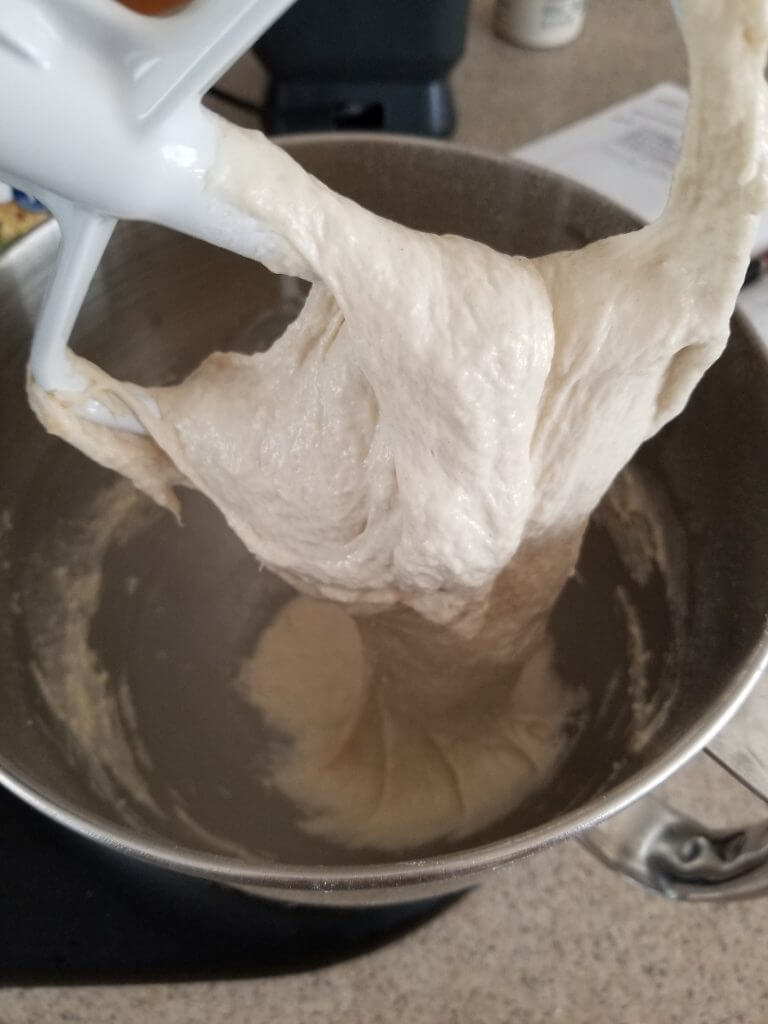
Next, change your attachment to the hook for your standing mixer.
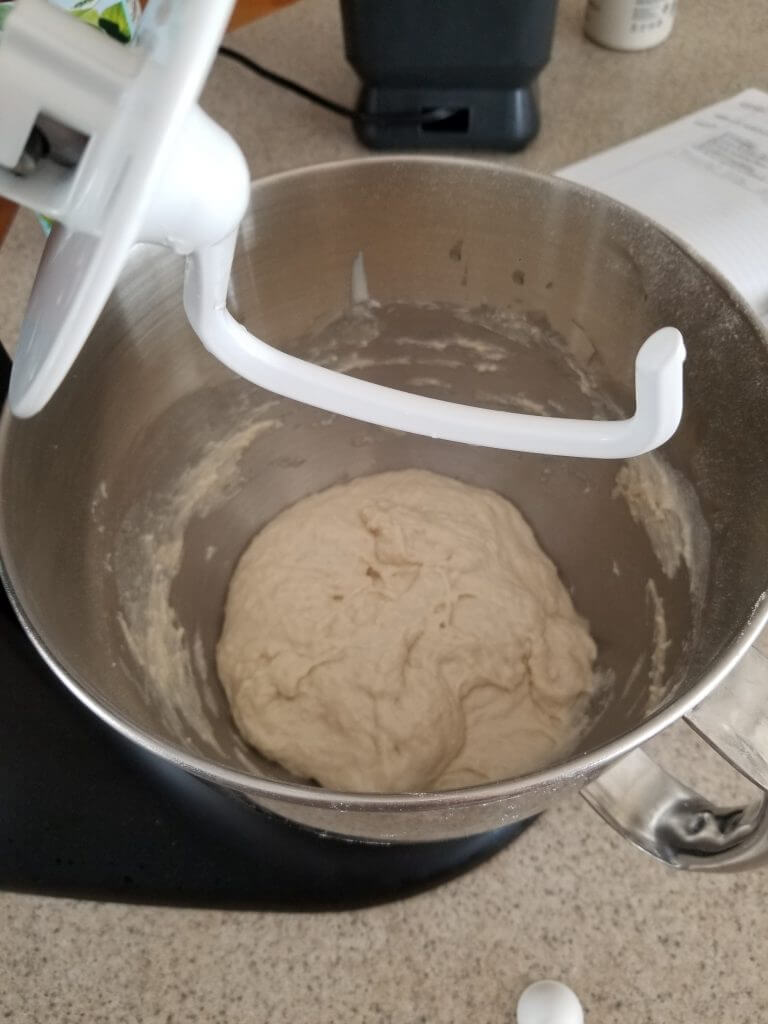
Set the speed to medium low and let the dough mix for about 10 minutes.
You will see the ciabatta dough staying together even better and it should look shiny.
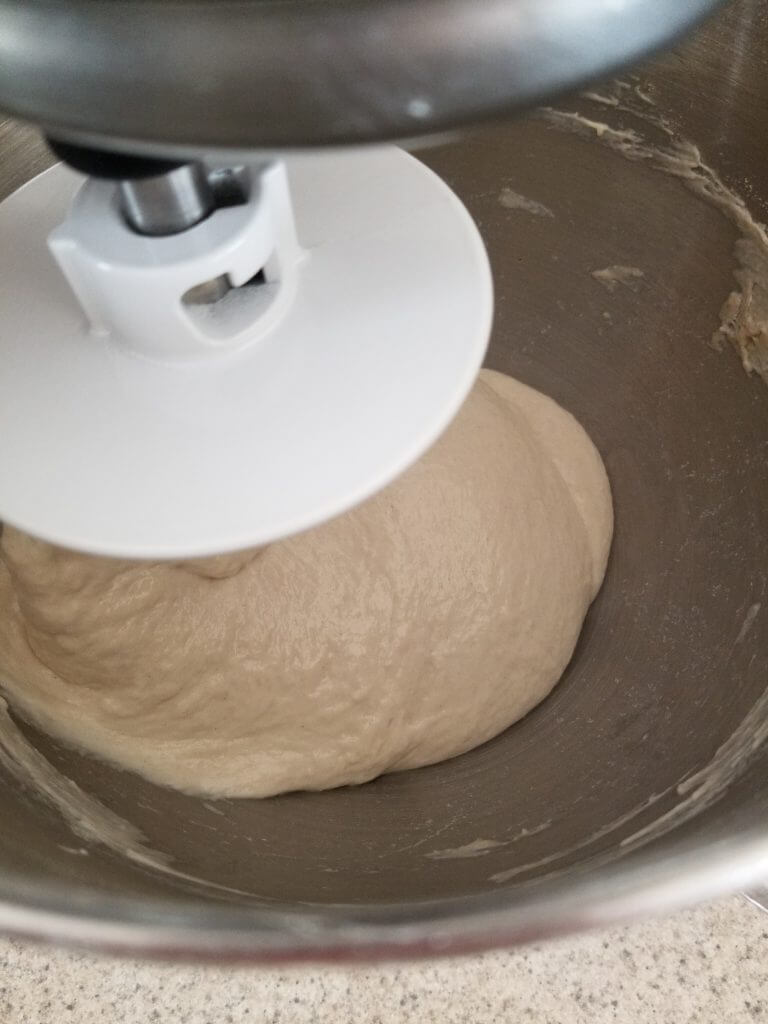
It will still be pretty thin/sticky but it should be very strong! You can test the dough strength by pulling the hook up and seeing if your dough stays together.
It should look like this:
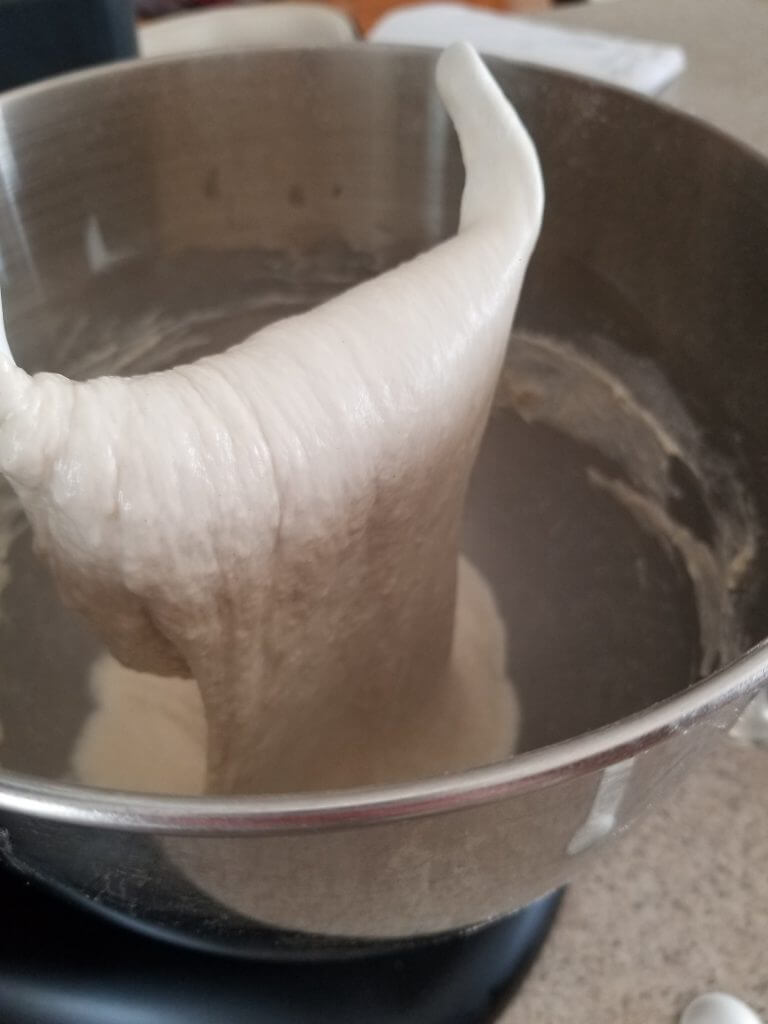
Gently transfer your dough into a clean bowl.
If you are mixing your dough by hand: mix your dough with lightly floured hands in the bowl until it is shiny and elastic. You can do the "stretch test" to see if it is done by pulling the dough and if it does not break in half easily, it is strong enough and you can quit kneading.
STEP 3: Rise and Fold the Ciabatta Dough
Cover the bowl tightly and let it sit somewhere warm for 1 hour.
Before 1 hour:
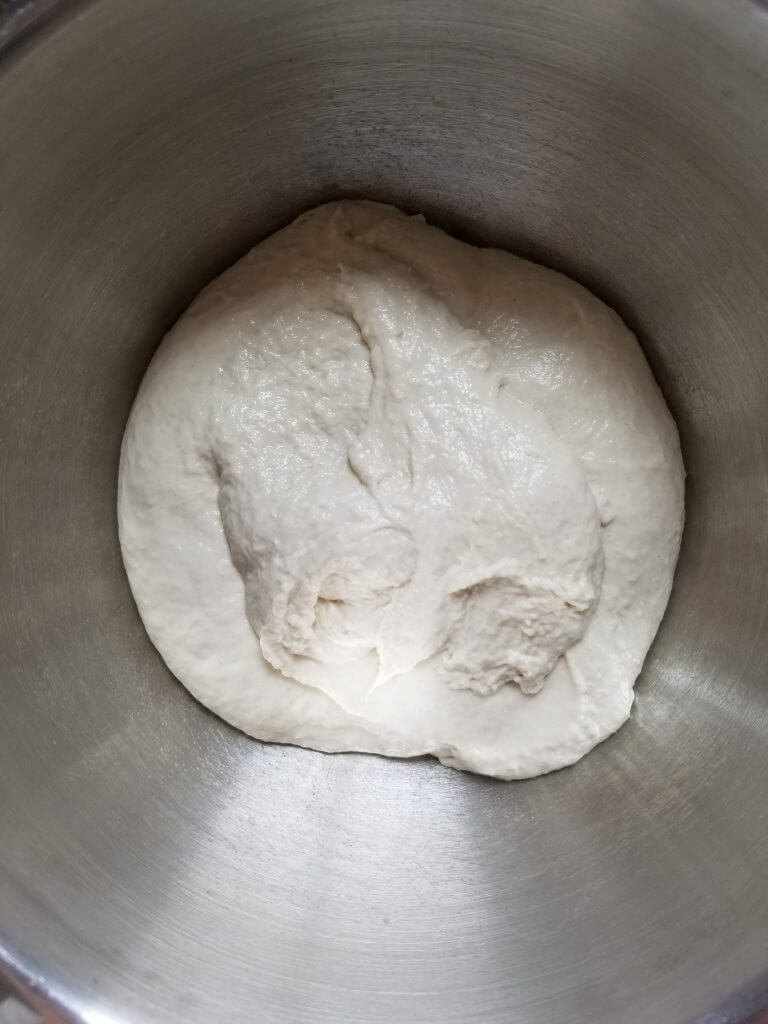
After 1 hour it will double in size:
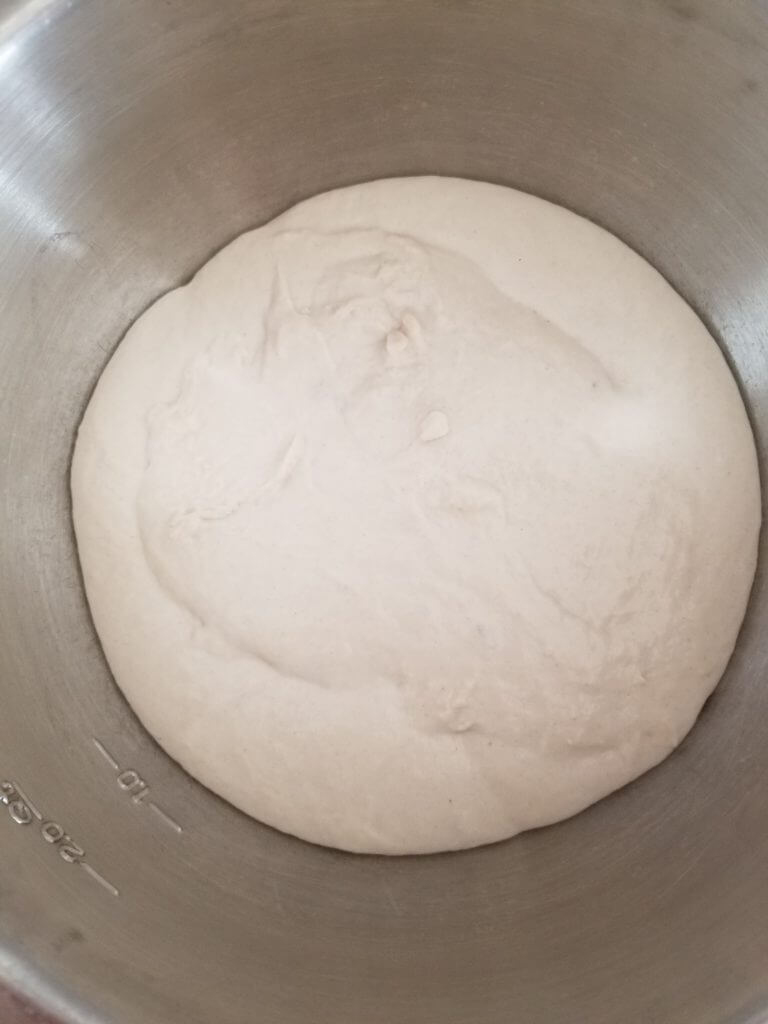
Drizzle the ciabatta dough with a 1 tablespoon of olive oil.
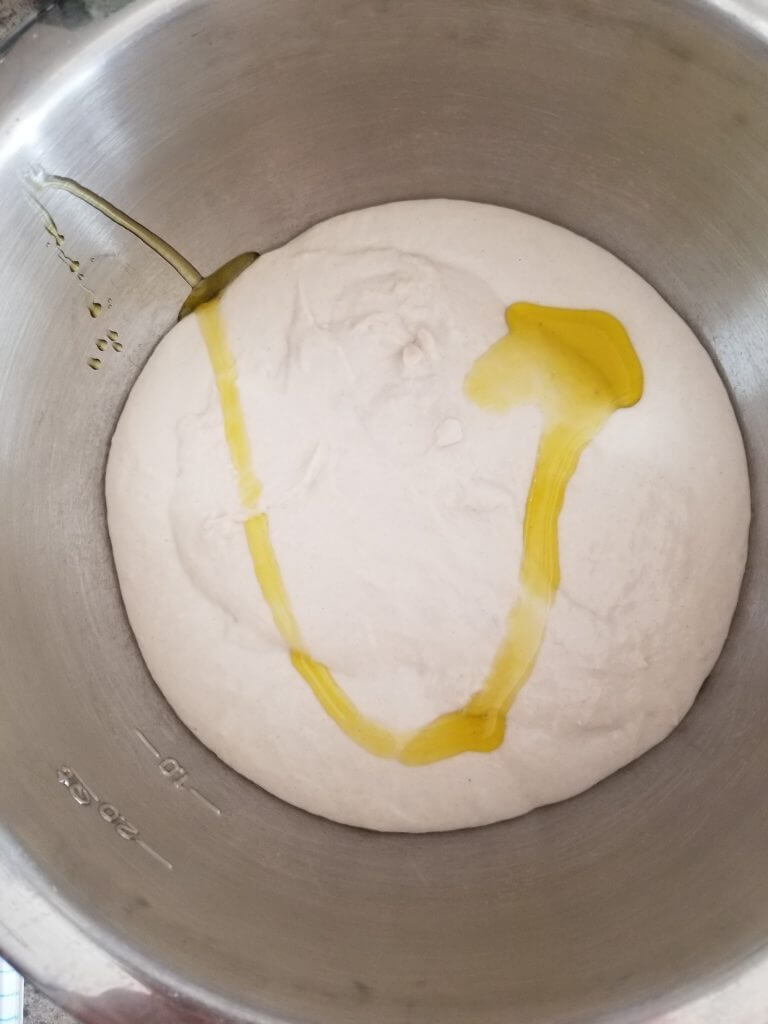
Rub the oil all over the surface of the dough.
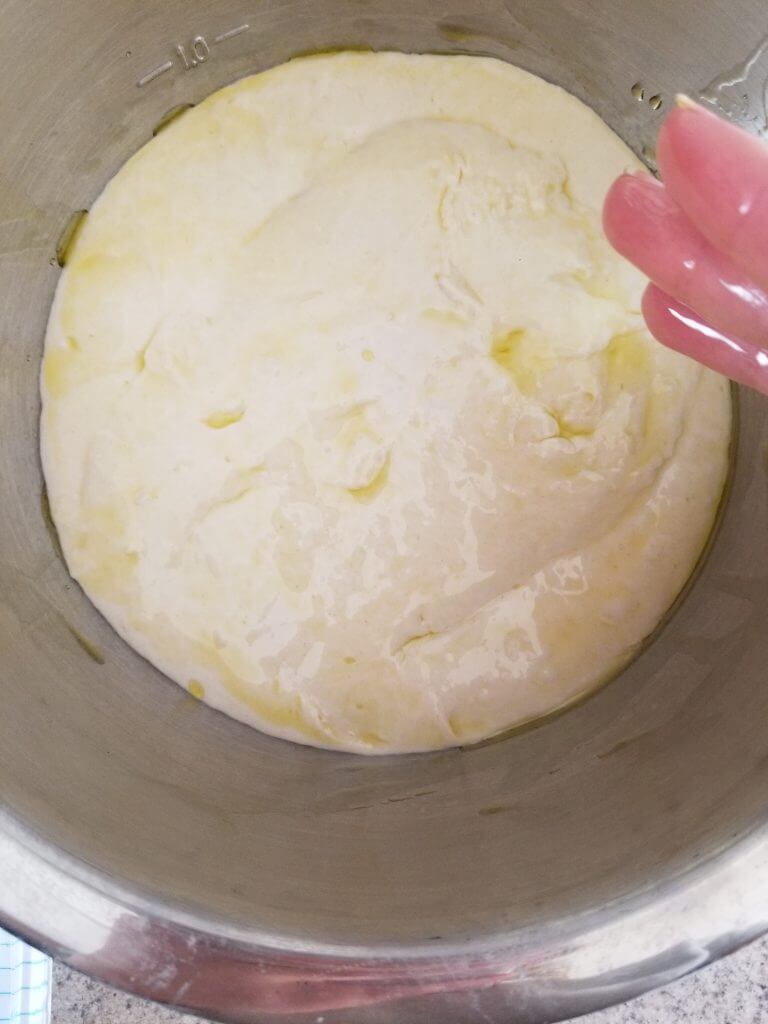
Next, stretch and fold the dough 6-8 times (stretch up and towards the center, pulling the dough away from the sides). Stretching and folding the dough will help strengthen your ciabatta dough to get those big ciabatta bread bubbles and holes.
Cover the bowl and let it rise again for 30 minutes.
Repeat the stretch and fold process again 1 more time with another tablespoon of olive oil & rise again for 30 minutes, covered tightly.
Finally, turn your dough onto the floured surface of a clean counter.
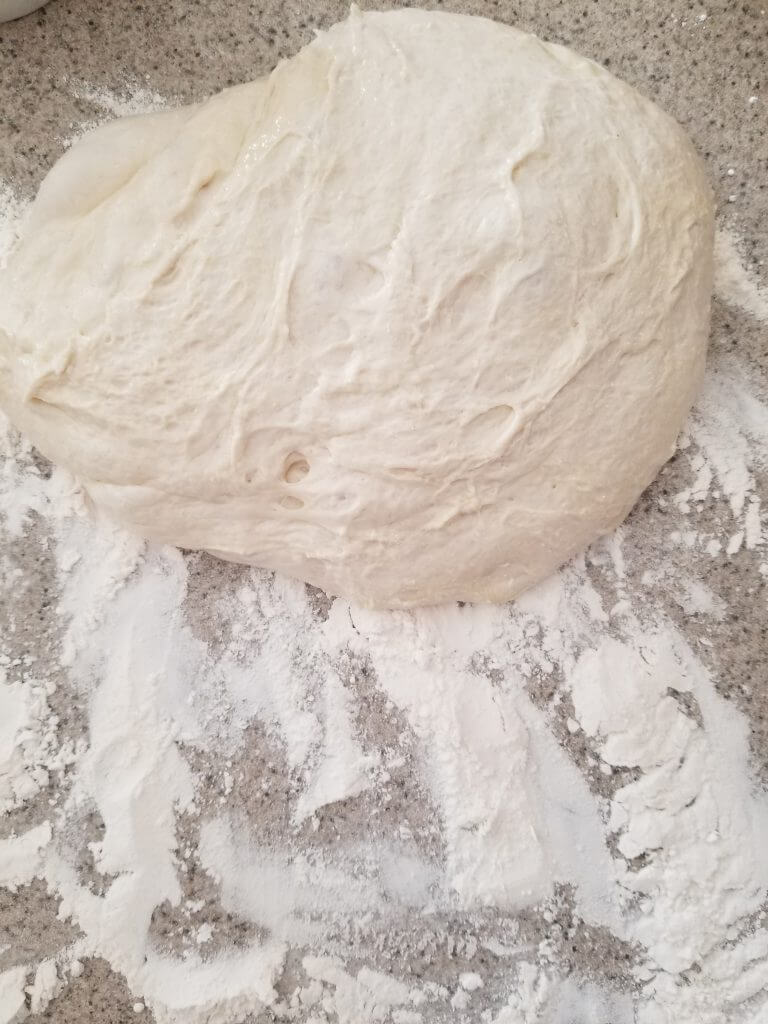
Cut the dough in half with a floured knife.
Flouring a knife helps it to prevent from sticking to your delicate dough!
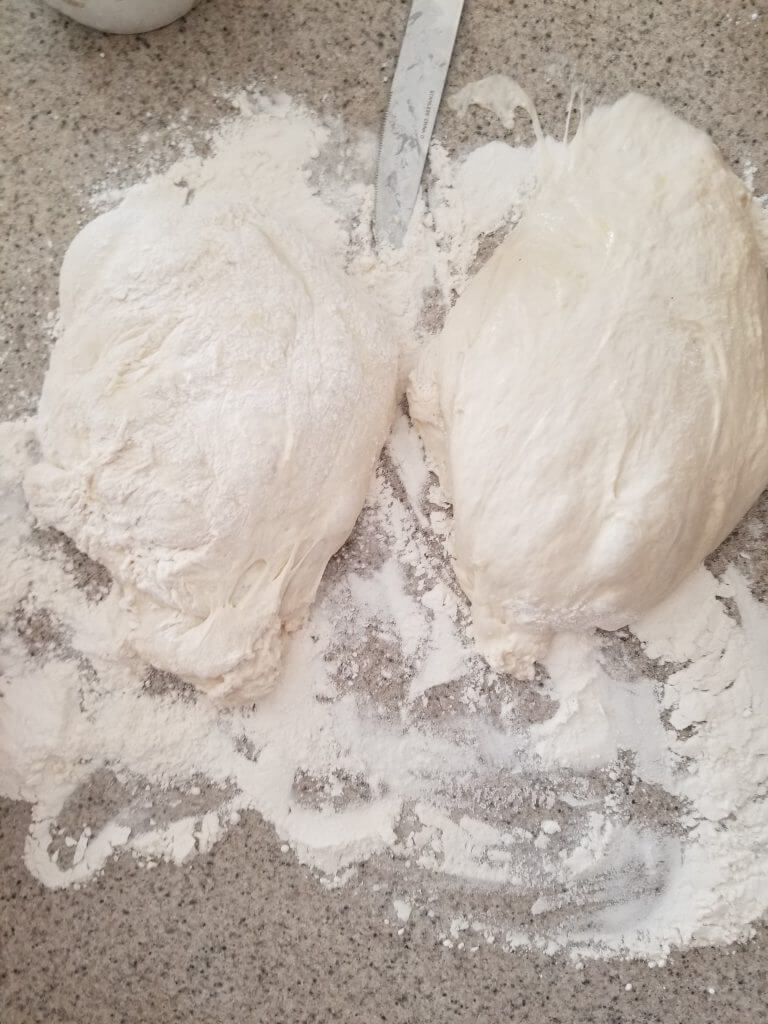
Gently press each half into the shape of a 12 x 6 rectangle.
TRY NOT TO DEFLATE ANY BUBBLES! Unlike other bread doughs, we want to keep these bubbles that is where you get those big ciabatta holes.
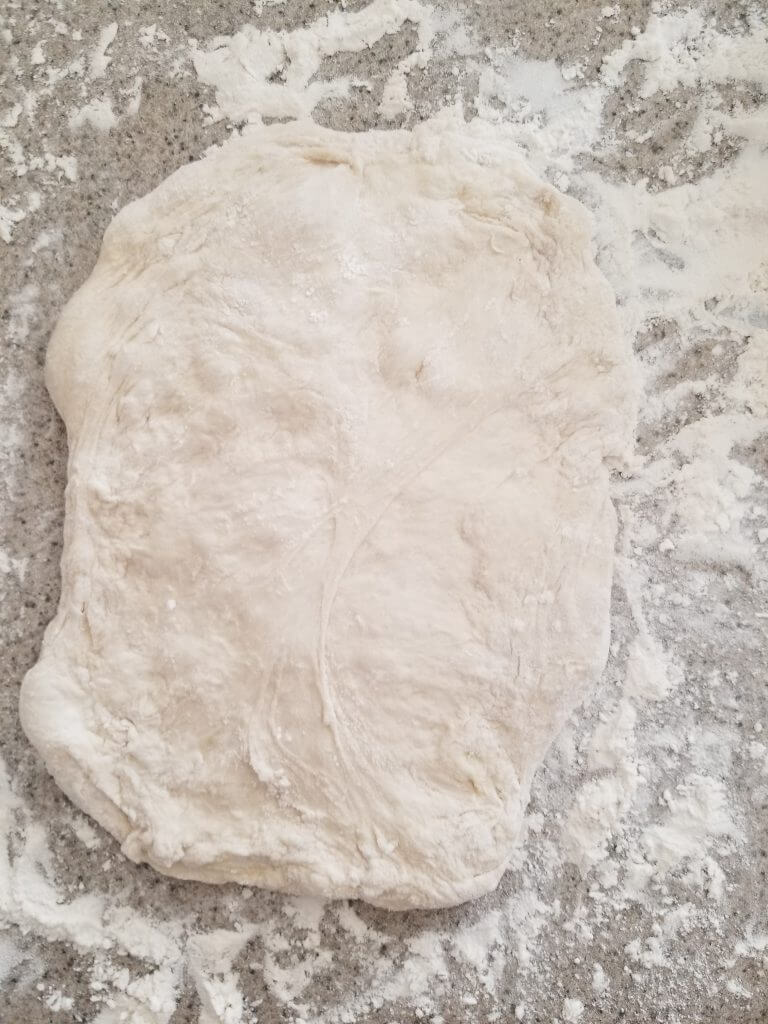
Fold each piece up like a letter: turning the two shorter ends into the middle.
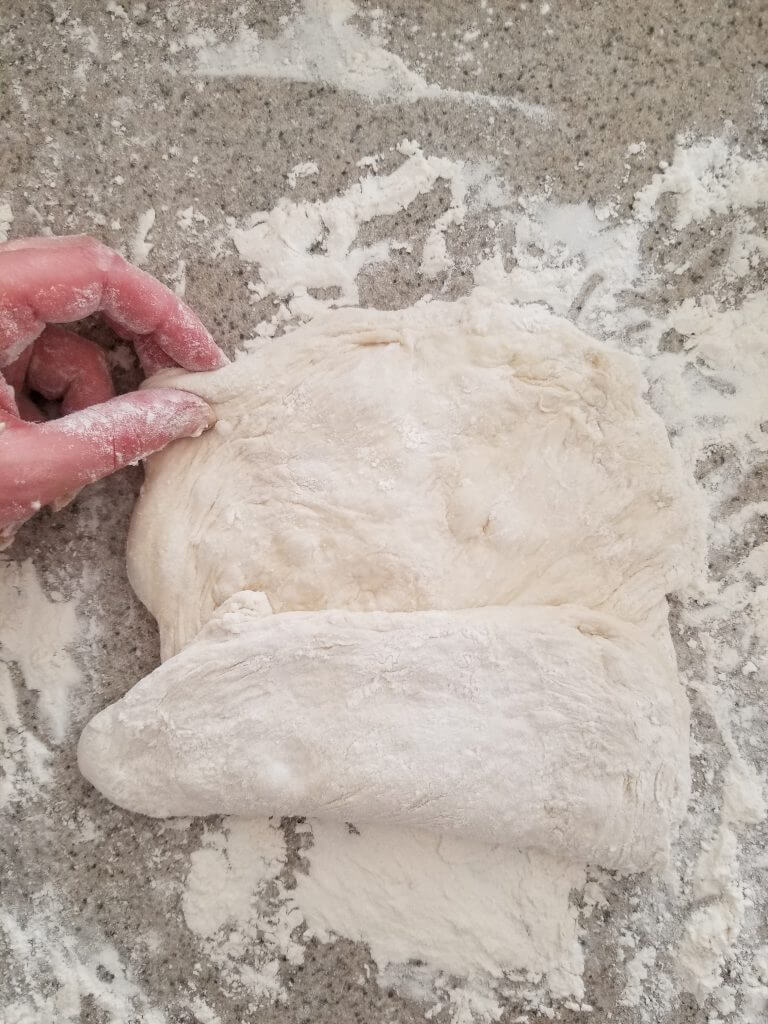
Place your folded dough on a parchment paper lined tray (seam side down) and let it rise by the warm stove for ~30 minutes.
At this point, place 2 Dutch ovens in your oven and preheat to 450 degrees while your ciabatta loaves rise.
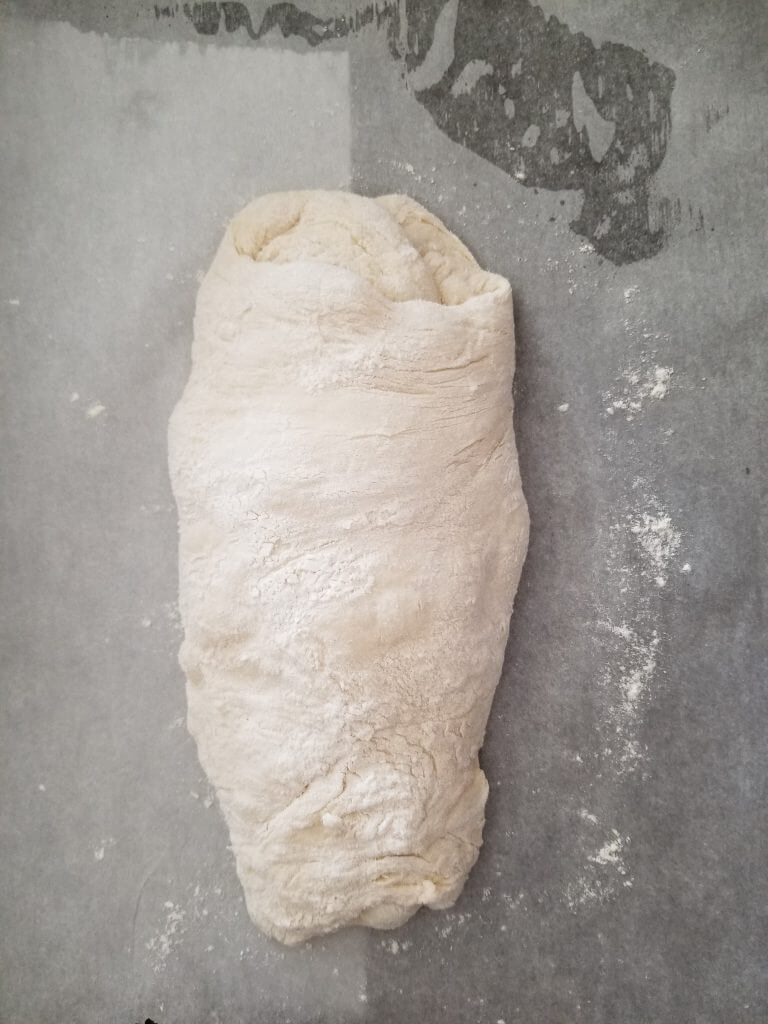
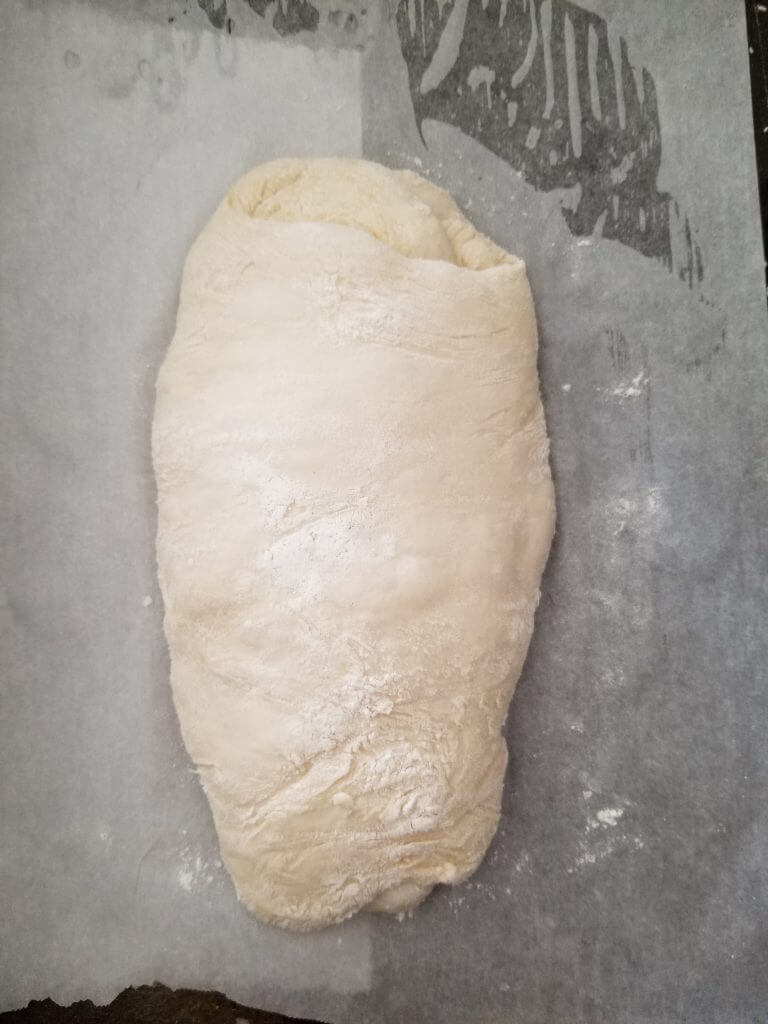
HOW TO BAKE CIABATTA BREAD IN YOUR DUTCH OVEN
After the folded loaves rise for 30 minutes, remove the hot dutch oven from your oven. Carefully remove the lids.
In each dutch oven, place one of the ciabatta bread loaves. Place the dutch oven lids back on top.
Bake in your oven for 15 minutes with the lid on.
Remove the lids from the dutch oven and bake another 10 minutes without the lid.
Cool completely before slicing.
This homemade ciabatta bread is my new favorite recipe!!
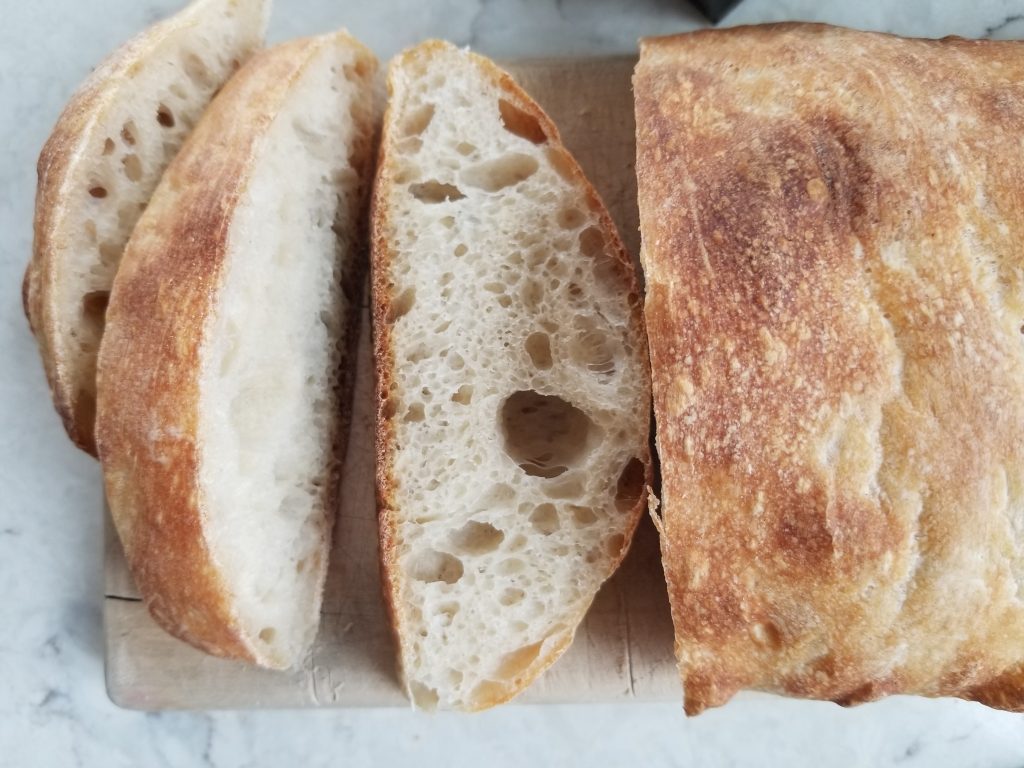
It is soooo spongy you can squeeze it and it bounces right back into shape!!
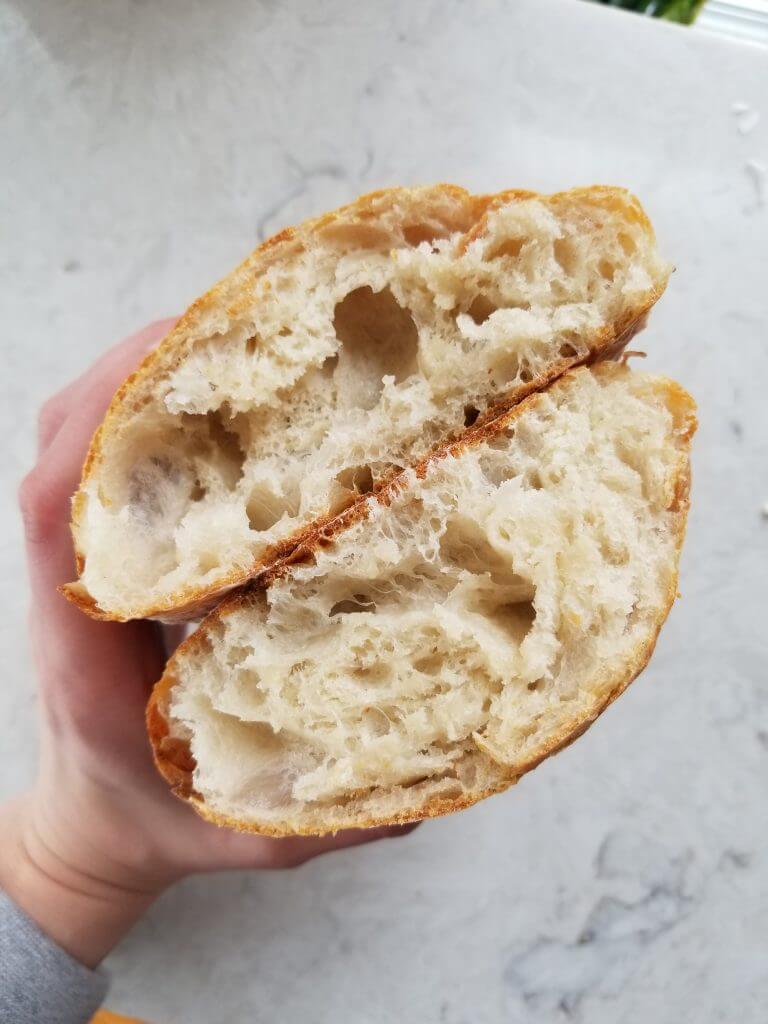
HOW TO BAKE CIABATTA BREAD WITHOUT A DUTCH OVEN
After you let the folded ciabatta loaves rise for 30 minutes, flour your fingers. Gently poke the entire surface of each loaf to form a 10 x 6 rectangle.
**TRY NOT TO DEFLATE THE BUBBLES
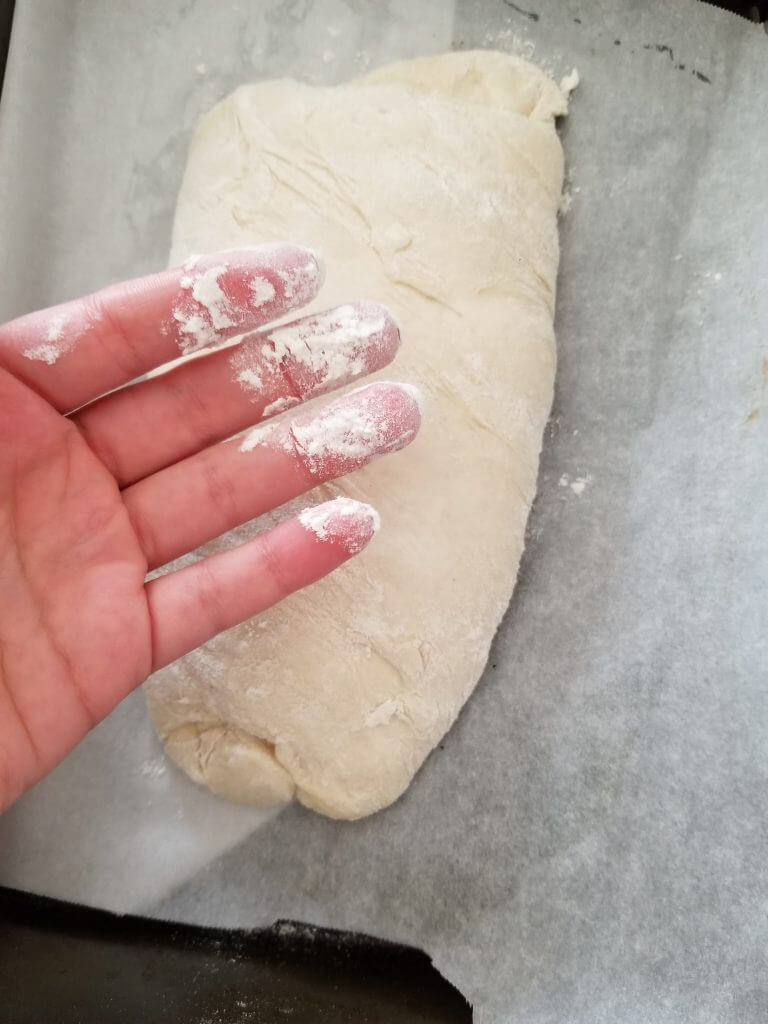
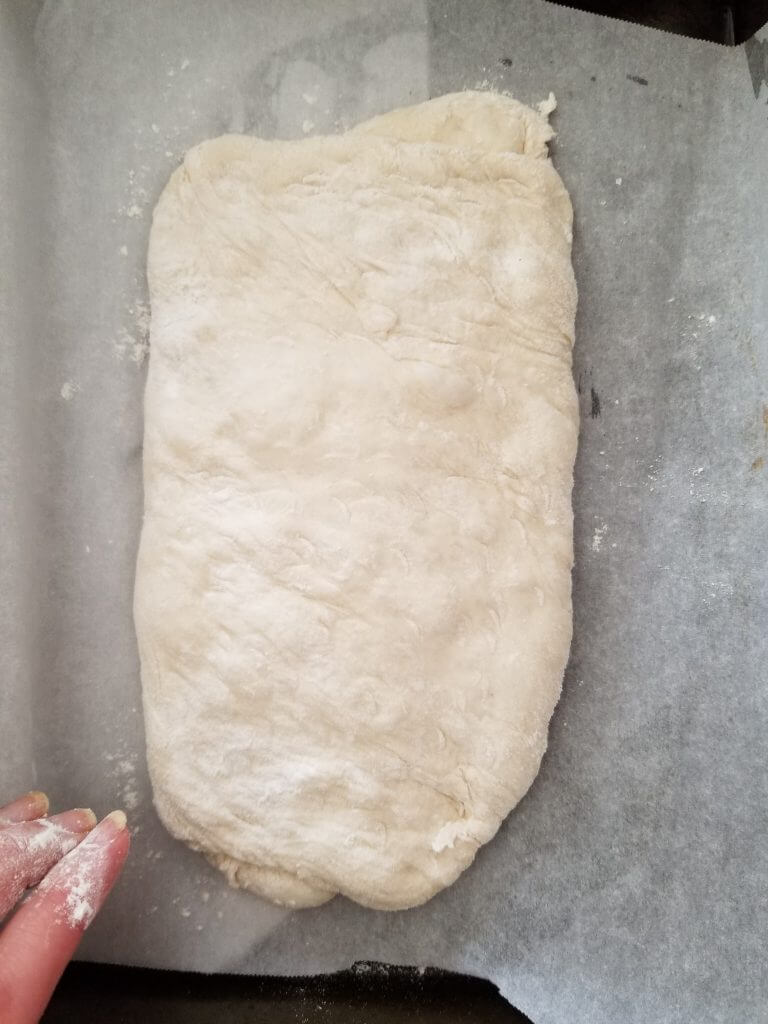
Finally your ciabatta bread is ready for baking!
Spray your ciabatta bread loaf with water before putting it in the oven.
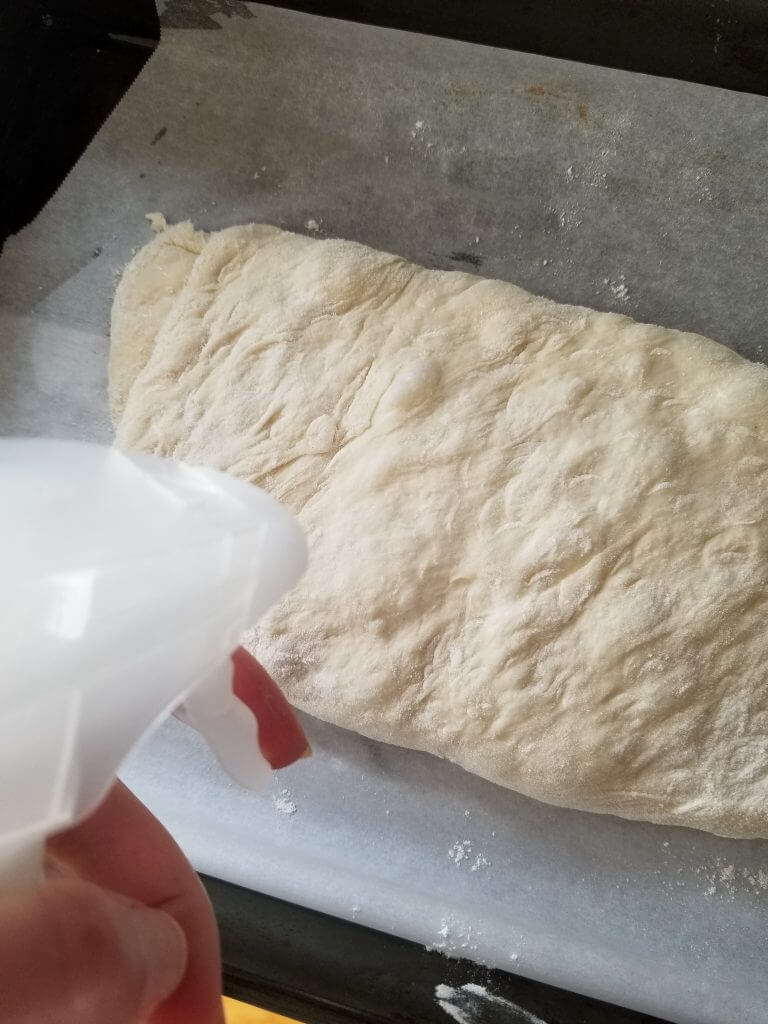
During the first 5 minutes of baking spray it again 3 times. This is about every 1.5 minutes. Make sure to rotate the pan as you spray it so that all sides of the loaf get wet. Spraying is important and creates steam in the oven to get a nice crispy crust.
After spraying it a final third time, bake for an additional 22 minutes or until it is golden brown.
Allow your bread to cool on a wire rack.
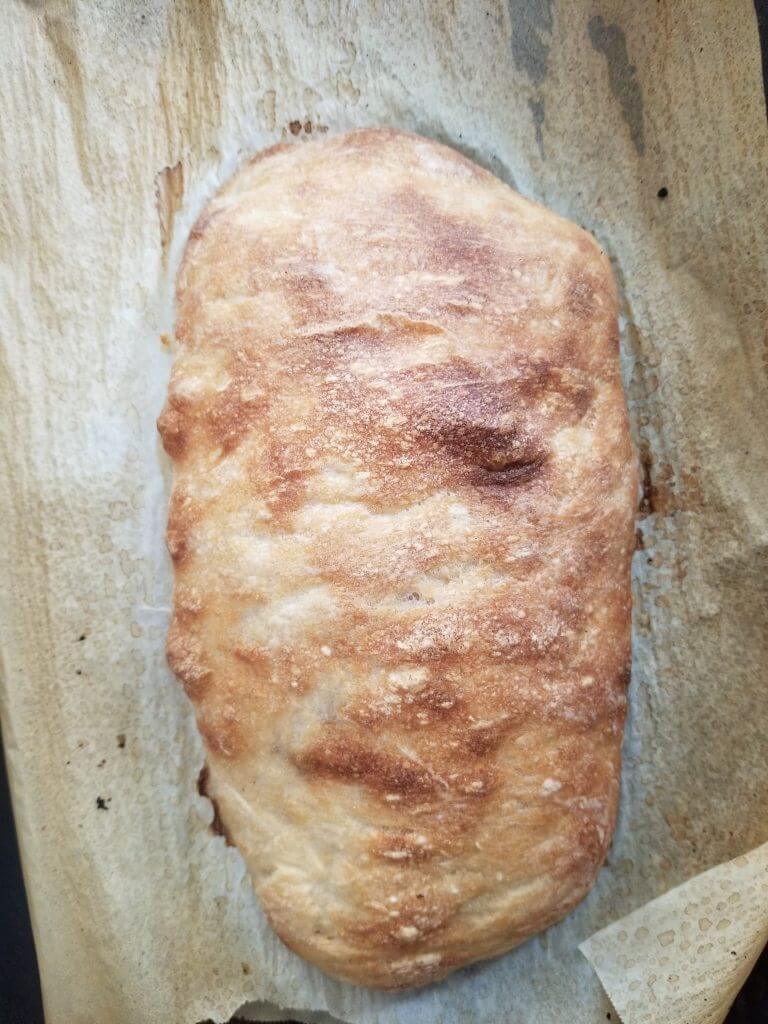
NO DUTCH OVEN CIABATTA BREAD:
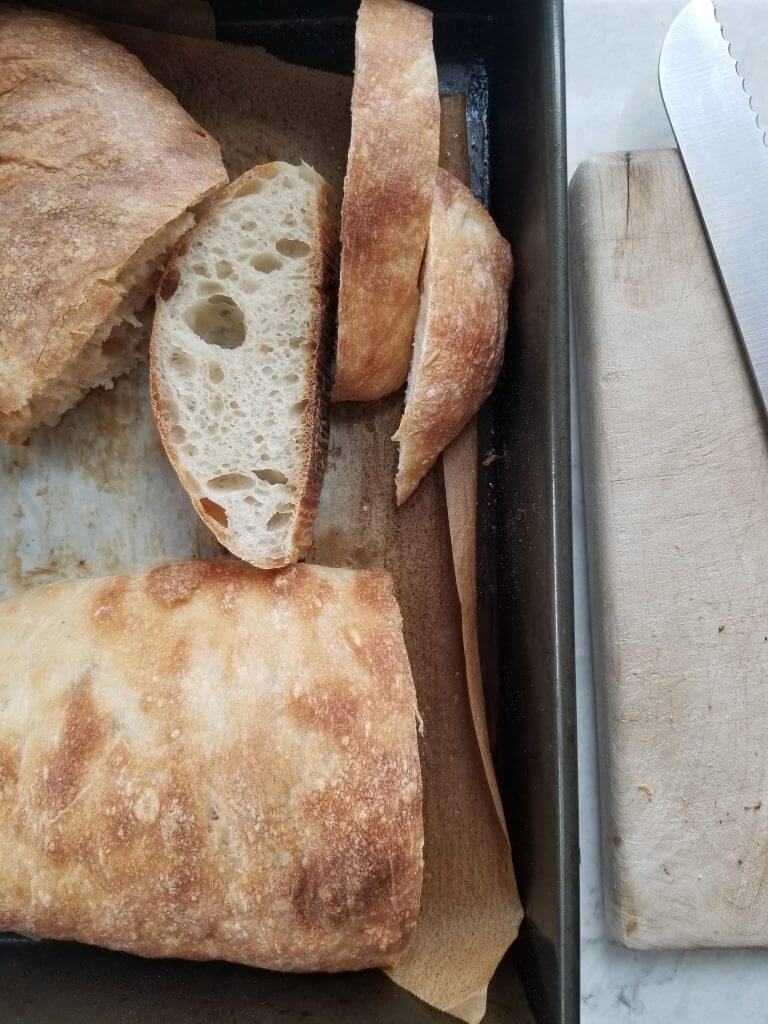
DUTCH OVEN CIABATTA BREAD:

Love trying new cuisines at home and want to try truly unique recipes? Make sure to check out my complete guide on Cooking Authentic Arabic Food at Home!
FAQ'S
What makes ciabatta bread different?
Unlike other Italian bread recipes, ciabatta bread is made with a pre-ferment (called a sponge). This extra fermentation time helps to give you that delicious ciabatta bread taste with big airy holes.
What is the difference between all-purpose flour & bread flour?
Bread flour has a higher percentage of protein than all-purpose flour has. This means that you will get more of a rise with bread flour. And because of the higher protein content you will get that iconic chewy ciabatta bread texture.
How do you get big holes in ciabatta?
If you want big holes in your ciabatta bread, you have to stretch and fold the dough every 60 minutes during the first rise of the ciabatta bread to make the dough stronger.
Also, you have to be very gentle when you are shaping the loaf during the second rise so that you don't pop any of the holes.
Can you leave your ciabatta dough overnight?
While you need to leave your sponge a good 8-24 hours to ferment, I wouldn't recommend leaving your actual ciabatta dough overnight. If your bread sits too long, the gluten can actually weaken and you will not get a nice rise and texture after baking. Over-proofed bread often has a gummy and crumbly texture because the gluten was over developed.
However, some people will leave their dough in the fridge overnight so they can bake it fresh in the morning. Putting your dough in the fridge will slow down the gluten development.
Does ciabatta need steam?
Yes! Ciabatta bread needs steam while baking. Similar to cooking your sourdough bread in a dutch oven in the first part of baking, spraying ciabatta bread during the first couple of minutes help to create that signature crispy shell.
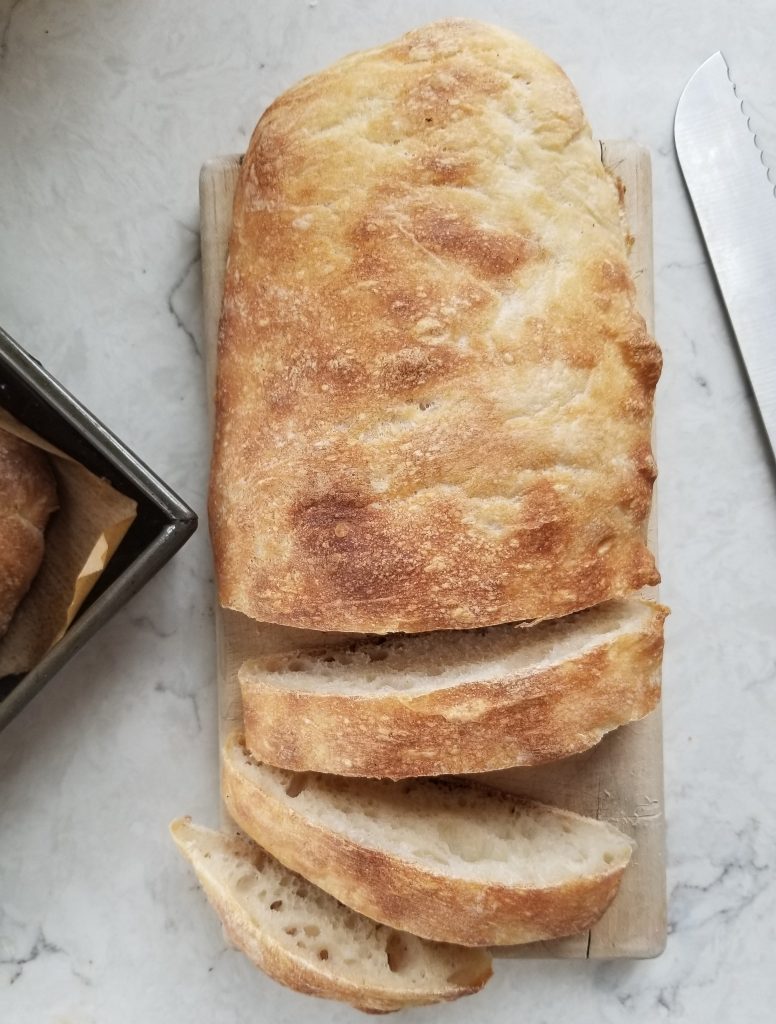
If you try my Dutch Oven Ciabatta Bread Recipe, please let me know your thoughts by leaving a rating and comment below! Ready for more? Subscribe to my newsletter or follow along on Pinterest, Instagram, Facebook, and Youtube!
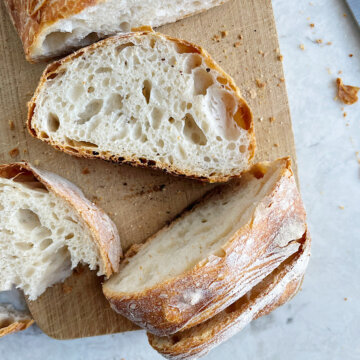
Homemade Ciabatta Bread (dutch oven and no dutch oven versions)
Equipment
- Parchment paper
- baking sheet
- Spray bottle
Ingredients
For the sponge:
- 1 cup all-purpose flour (unbleached unenriched) sub white wheat flour
- ⅛ teaspoon instant yeast
- ½ cup water at room temperature
For the dough
- 2 cups bread flour sub white wheat bread flour
- 1 ½ teaspoon pink sea salt
- ½ teaspoon instant yeast
- ¾ cup water at room temperature
- ¼ cup organic plain yogurt
For kneading/rolling:
- 2 tablespoon olive oil
Instructions
How to make the ciabatta sponge (aka pre ferment):
- In a bowl add the 1 cup unbleached all-purpose flour, ⅛ teaspoon instant yeast, and ½ cup of room temperature water.1 cup all-purpose flour (unbleached unenriched), ⅛ teaspoon instant yeast, ½ cup water at room temperature
- Mix until it forms a ball.
- Cover your bowl tightly with plastic wrap (or a beeswax wrap like I use to be eco friendly). A thick towel also works.
- Let your sponge sit at room temperature for 8-24 hours or until it looks very bubbly and has tripled in size.(the warmer your kitchen, the faster it will ferment & form air bubbles)
How to make the ciabatta bread dough:
- In the bowl of a standing mixer, add 2 cups of bread flour, 1 ½ teaspoon salt, ½ teaspoon instant yeast, ¾ cup room temperature water, ¼ cup plain yogurt, and the sponge.2 cups bread flour, 1 ½ teaspoon pink sea salt, ½ teaspoon instant yeast, ¾ cup water at room temperature, ¼ cup organic plain yogurt
- Fit the mixer with the paddle attachment. Mix on low speed for ~1 minute. Turn the mixer off and scrape the bowl as needed.
- Increase the speed to medium low and mix for ~4-6 minutes, or until the the dough pulls away from the sides of the bowl and forms a uniform mass.
- Change to a hook attachment.
- Mix on medium low speed for ~10 minutes or until the dough becomes shiny and comes together more.
- The dough will be very sticky.
- Carefully transfer the dough to a clean bowl. Cover it with a towel and let it rise somewhere warm for ~1 hour.
- Drizzle the top of the dough with ~1 tablespoon olive oil (or just wet your hand). Rub the oil over the dough. Stretch & fold the dough 6-8 times in the bowl. Cover the dough again and let it rise ~30 minutes.2 tablespoon olive oil
- After 30 minutes, repeat the step above one more time:Drizzle the top of the dough with ~1 tablespoon olive oil (or just wet your hand). Rub the oil over the dough. Stretch & fold the dough 6-8 times in the bowl. Cover the dough again and let it rise ~30 minutes.
HOW TO FORM YOUR LOAVES OF CIABATTA:
- After the second 30 minute rise, preheat the oven to 450 degrees F and place 2 Dutch ovens to heat up in your oven.
- While the oven and Dutch oven heats, form your loaves. Transfer the dough to a lightly floured counter top.Cut the dough in half with a floured knife (this helps prevent the dough from sticking to the knife).
- Stretch each of the halves of dough into a rough 12x6 inch rectangle. **TRY NOT TO DEFLATE THE BUBBLES.
- Fold the rectangle like you would a letter (in thirds): the first short side towards the middle, then the last side on top of the middle.
- Sprinkle medium-coarse cornmeal across a small piece of parchment paper. Carefully flip each loaf onto the cornmeal so that it is seam side down. Cover the loaves with your towel and let them rest about 30 minutes.
HOW TO BAKE CIABATTA BREAD IN YOUR DUTCH OVEN.
- After 30 minutes, take the hot dutch ovens from your oven. Remove the lids. Carefully put one ciabatta loaf into each dutch oven, seam side down (this is where the parchment paper helps transfer the loaves into the dutch oven). Place the lid back on the dutch oven.
- Bake at 450F for 15 minutes, covered.Remove the lids and bake an additional 10 minutes at 450F.
- Once the tops of your ciabatta loaves are golden brown, remove the dutch ovens. Transfer the ciabatta loaves to a cooling rack to cool completely.
- Slice and enjoy!
- Store ciabatta bread covered tightly at room temperature for up to 1-2 days, it goes stale very quickly! Store in the freezer for up to a month!
Video
Notes
- Follow all ciabatta dutch oven directions until you get to the folding the two bread loaves. Now, instead of heating the dutch oven in your oven, simply preheat your oven to 450 degrees Fahrenheit. Line 2 trays with parchment paper.
- Form the 2 loaves exactly the same as above, by stretching into a rectangle and then folding like a letter. Place each of the formed loaves seam side down on the parchment paper lined sheet. Rest the same as the above loaves, for 30 minutes while the oven heats.
- After 30 minutes, flour your fingers. Gently poke the entire surface to form a 10x6 rectangle, trying not to poke any of the bubbles.
- Place trays on the center rack of the oven.
- Use a spray bottle to spray the ciabatta loaves with water 3x during the first 4-5 minutes of baking (this is about every minute and a half). This creates steam for a crispy ciabatta shell. Make sure to rotate the pan so all sides are sprayed.
- After you finished spraying the ciabatta bread for the third time, bake an additional 22 minutes or until the top is golden brown.
- Remove your bread from the oven and allow it to cool on a wire rack.
Nutrition
If you enjoyed my Dutch Oven Ciabatta Bread Recipe, make sure to pin it for later!



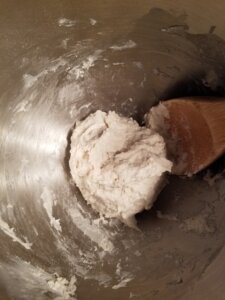
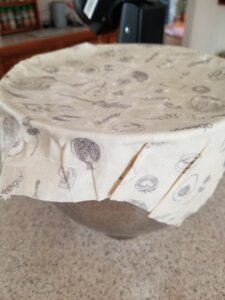
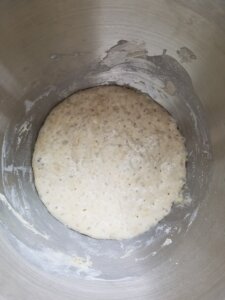
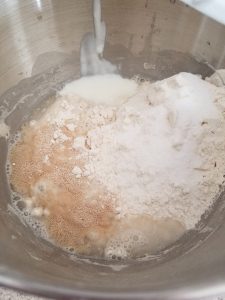
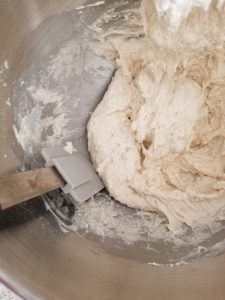
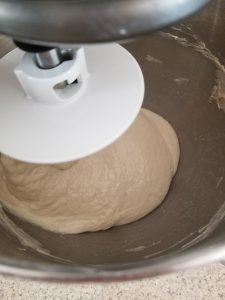
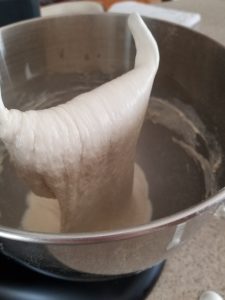
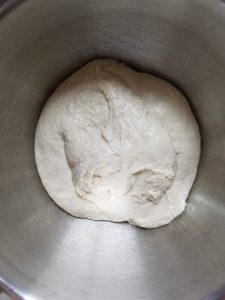
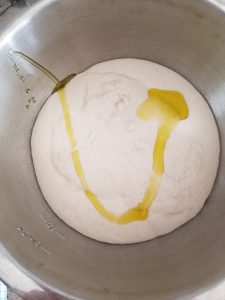
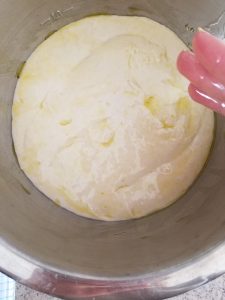
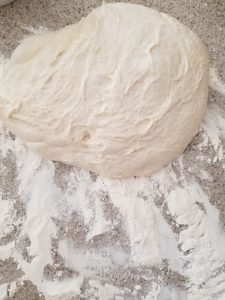
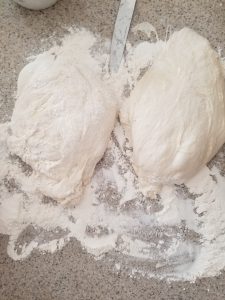
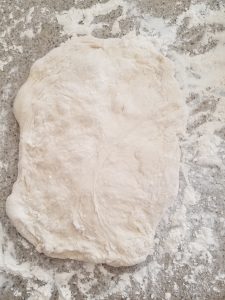
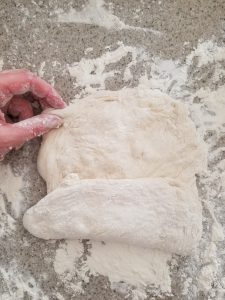
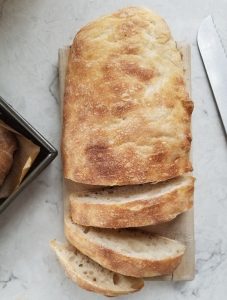


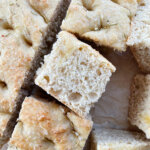

Tammy
Your directions are SO easy to follow and descriptive!
I made the Dutch oven version and it came out incredible thank you so much!!